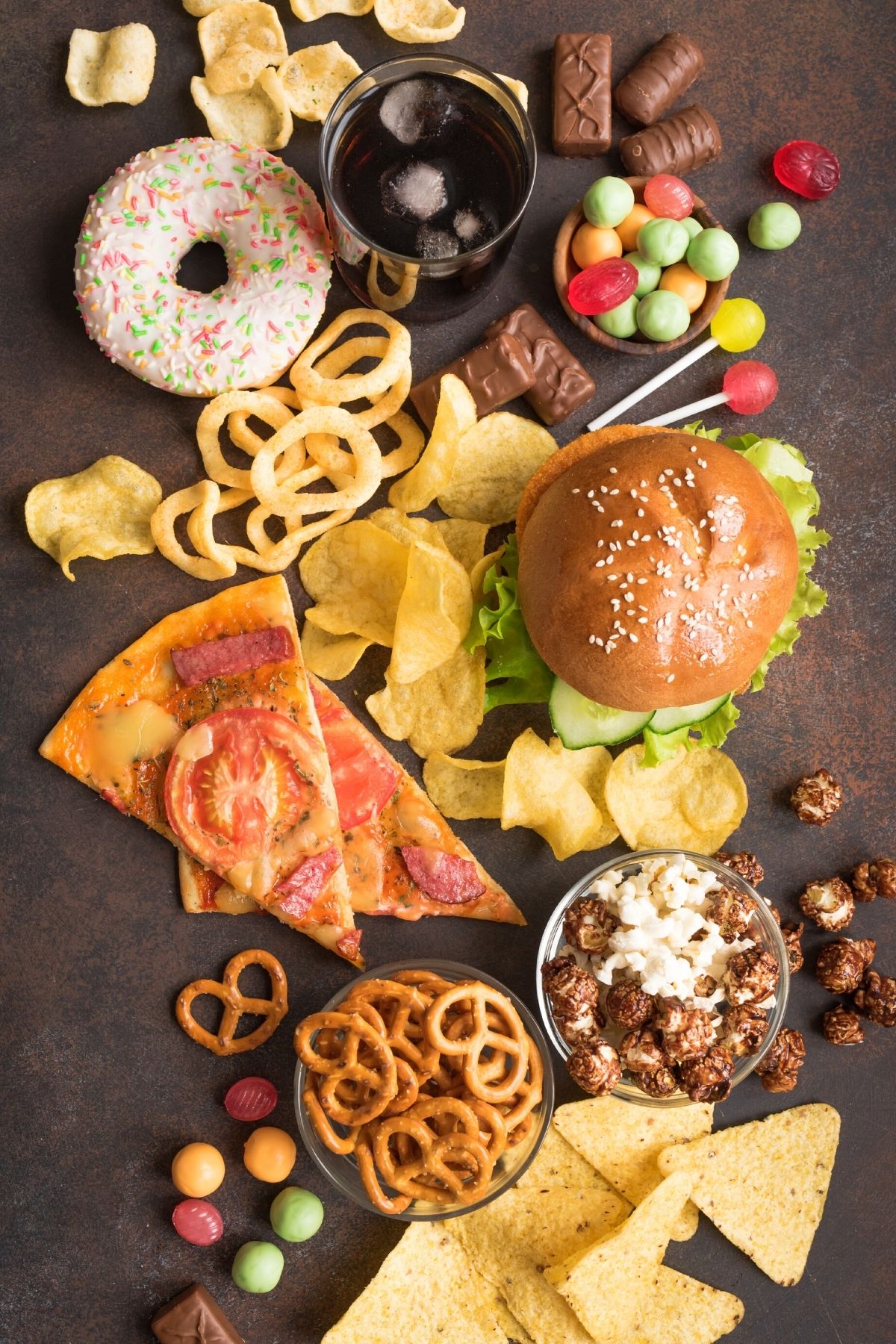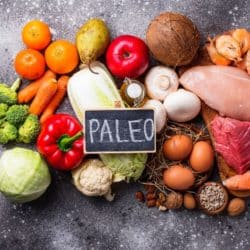What are the Worst Foods for Hashimoto’s?
Hashimoto’s Thyroiditis is an autoimmune disease of the thyroid. There are some proven dietary and lifestyle interventions to help manage the symptoms. In this article, we review the worst foods for Hashimoto’s disease.

As someone who suffered for many years with thyroid disease, I know how frustrating the symptoms can be! Luckily, scientists have researched the root causes of Hashimoto’s disease and have developed nutritional protocols and even medications to help.
If you are recently diagnosed with Hashimoto’s and you need some nutrition guidance, then hopefully this article will help determine which foods you should eliminate first.
As always, be sure to discuss any dietary changes with your healthcare provider to determine what is the best course of action for you.
And, if you’re looking to switch to a functional medicine practitioner to help manage your Hashimoto’s, then check out my article on how to find functional medicine doctors near me.
You may also want to check out this article on the Symptoms of a Hashimoto’s Flare-Up.
Worst Foods for Hashimoto’s
1. Gluten
Gluten is a type of protein that occurs naturally in wheat, barley, and rye grains. It acts like a glue, holding foods together and giving them their shape. For some people, however, gluten can be problematic. It can trigger an immune reaction that can cause damage to the lining of the small intestine. This sensitivity is known as celiac disease.
Research has shown that people with autoimmune thyroid disorders like Hashimoto’s are more likely to have celiac disease than others. This is why it is common for doctors to screen for celiac disease after a diagnosis of Hashimoto’s.
But even if you don’t have celiac disease, you may still want to discuss a gluten-free diet with your health care provider.
Various studies have shown that cutting gluten and grains out of the diet can be beneficial if you suffer from Hashimoto’s thyroiditis. In this study, 16 women with the condition followed a gluten-free diet for 6 months, with the researchers concluding that there were clear clinical benefits compared to the control group.
There are a couple of reasons why cutting out gluten may be helpful if you suffer from Hashimoto’s.
Gluten is believed to trigger the release of zonulin in some people.
Zonulin is a protein that opens and closes the spaces between cells in the gut. When zonulin levels are high, those spaces remain open, causing inflammation and a “leaky gut”. An unhealthy gut is believed to play a big part in the development of Hashimoto’s. See my related article on the best leaky gut diet.
Poor gut health can also make it difficult for your body to absorb the nutrients it needs. A deficiency in selenium, in particular, is very relevant to autoimmune thyroid disease . Studies have shown that optimum levels of selenium are important for healthy thyroid function.
Read more about the reasons to go gluten-free.
In order to cut gluten out of your diet, you will need to avoid products made with wheat, barley, and rye. This will include things like bread, pasta, cookies, and cakes.
You should also check the packaging of any processed foods that you buy, because gluten is often a hidden ingredient.
Fortunately, there are many gluten-free products available in stores these days that make following a gluten-free diet much easier. And, in case you didn’t know, Clean Eating Kitchen is a 100% gluten-free recipe site! See my full gluten-free recipe index.
You may also like my list of the best gluten-free carbohydrates.
2. Dairy
Not everyone who suffers from Hashimoto’s thyroiditis is lactose intolerant, but this 2014 study showed that the percentage affected is higher than in the general population. In the same study, these patients were given a lactose-free diet, and their TSH (thyroid-stimulating hormone) levels lowered as a result.
But this is just one reason why you should consider removing dairy from your diet. Another reason to consider eliminating dairy products is that your gut may incorrectly recognize the proteins in milk – casein and whey – as harmful. It will then make antibodies to deal with them, causing inflammation of the intestinal tract.
This, in fact, is similar to the problem that gluten sometimes causes. The end result is poor absorption of other nutrients. It may also make it harder for your body to absorb your thyroid medication.
To follow a dairy-free diet, you will need to cut out cow’s milk (or foods containing it), cheese, butter, and yogurt. Because they contain similar proteins, you will also need to avoid sheep or goat milk. As an alternative, try plant-based products such as almond or coconut milk.
See my article with tips for starting a gluten-free and dairy-free diet. You may also want to read this article with reasons to go dairy-free.
3. Sugar
Eating too much sugar can make it very difficult to manage Hashimoto’s thyroiditis. That’s because sugar is known to cause inflammation in the intestines.
Additionally, sugar spikes – where the blood sugar rises and then falls sharply – are believed by some practitioners to cause Hashimoto’s flare-ups
Unfortunately, studies have shown that artificial sweeteners, too, can be harmful to people with Hashimoto’s.
To cut down on your sugar intake, avoid sweetened drinks, desserts, cakes, and cookies. Check the packaging for processed foods – there will often be sugar in products you may not have considered, such as sauces and cereals.
If you’re new to a sugar-free diet, then you should also check out my articles on the best sugar-free foods, how to do a sugar detox, sugar-free diet benefits, and tips for a sugar-free diet.
4. Grains
Following a gluten-free diet will already cut out some grains, but a grain-free diet will mean avoiding them all. This means no millet, amaranth, bulgur, corn, or kamut. Some doctors even recommend cutting out “psuedograins” like quinoa and buckwheat.
Whilst there is not much scientific evidence supporting a grain-free approach, some Hashimoto’s sufferers find it useful. This may be because the proteins in these grains are similar to gluten, causing your body to react to them in the same way.
A grain-free approach is also part of a paleo diet and autoimmune paleo diet which can help manage symptoms of Hashimoto’s disease.
See all of my grain-free recipes.
5. Fast Foods and Highly Processed Foods
There are a couple of good reasons to avoid fast foods and processed foods when you have Hashimoto’s.
Firstly, it can be hard to eliminate dairy, gluten, sugars, and grains when consuming fast or processed foods, because it is not always clear exactly what they contain.
But just as importantly, fast or highly processed foods tend to offer little in the way of nutrition. With Hashimoto’s thyroiditis, keeping your gut healthy and your weight well-controlled is important for reducing symptoms. Whole foods – rich in antioxidants and with anti-inflammatory benefits – will help improve your overall health, keeping autoimmune flare-ups at bay.
See my suggestions for healthy foods to eat every day.
6. Other Highly Allergenic Foods
You may want to discuss with your healthcare provider the benefits of trying an AIP (Autoimmune Protocol) Diet. This is an elimination diet that removes all foods from the diet that have the potential to cause problems. Its aim is to reduce inflammation in your body and the symptoms that go with it.
Foods to avoid may include eggs, coffee, nuts, alcohol, nightshades (tomatoes, potatoes, peppers, and eggplants), grains, dairy, legumes, some oils, and certain food additives.
The idea is that you don’t consume these foods at all for a period of weeks, taking note of any changes in your health. Then, you begin to reintroduce them to your diet one at a time and note whether or not you react to them. This can be helpful in identifying the foods that give you problems.
Whilst this diet can be restrictive at first, research has shown promising results in people who followed it. This study of 16 women with Hashimoto’s disease, showed that inflammation levels were reduced with the AIP Diet and that the patients noted improvements in their quality of life as a result.
Additional Foods that May Need to Be Avoided
1. Nightshades
These are fruits and vegetables that are part of the Solanaceae family of plants. They include:
- bell peppers
- tomatoes
- white potatoes
- eggplant
- cayenne pepper
- crushed red pepper
- chili powder
- paprika
All of these contain a compound called solanine. Some people believe that solanine triggers the symptoms of inflammation, but there is no medical research to support this. What’s more, these fruits and vegetables contain lots of important nutrients, so it would not be helpful to eliminate them from your diet without good reason.
If you believe that nightshades may be contributing to your Hashimoto’s symptoms, then the best advice would be to avoid them all for a period of at least four weeks, keeping a note of the difference (if any) this makes to your symptoms.
After this time has passed, start adding the nightshades back into your diet one at a time and keep a note of how they seem to affect you. If your symptoms worsen then you will know that avoiding that particular nightshade might be the best thing for you.
2. Alcohol
Alcohol has long been known to have a negative impact on the way the thyroid functions. But it can cause other problems too. It has the potential to react with your medication – even over-the-counter medicines.
And, drinking too much alcohol can cause inflammation in the gut and beyond, especially when consumed in large amounts.
3. Legumes
Some people with Hashimoto’s thyroiditis find it useful to eliminate legumes like lentils, peas, chickpeas, beans, and peanuts from their diets. Although these foods are nutritious, they contain natural proteins called lectins that can cause inflammation in the gut in the same way that gluten does.
There are no medical studies that support eliminating legumes from your diet just because you suffer from Hashimoto’s.
But if you believe that these foods may aggravate your symptoms, then you may want to try avoiding them for at least a month, then reintroducing them slowly and looking out for any reactions.
4. Soy
There is no clinical recommendation for people with Hashimoto’s disease to avoid soy.
However, a 2016 study into the effects of a low-carbohydrate diet on overweight subjects with autoimmune thyroiditis listed soy as a goitrogenic food that interferes with iodine metabolism. This, in turn, can have a negative effect on thyroid function.
If you do want to consume soy, it is recommended that you make sure you are consuming enough iodine too.
Remember that soy is a common ingredient in pre-packaged food. It is often listed on the label as texturized vegetable protein or hydrolyzed vegetable protein. See my tips on how to eat soy safely.
5. Goitrogens
There are some types of foods that are knowns as goitrogens. These foods may disrupt the production of thyroid hormone in the body and include:
- Raw leafy greens and other cruciferous vegetables
- Microgreens and sprouts
- Sweet potatoes
- Soy products
- Cassava
See this list of goitroenic foods. Speak with your healthcare provider to see if you need to avoid this class of foods.
What to Eat with Hashimoto’s
Even with all the restrictions listed above on what not to eat with Hashimoto’s, don’t worry! There are tons of real, whole food fruits, vegetables, nuts, seeds, lean proteins, and other whole foods that are available to you.
Check out my clean eating shopping guide which is gluten-free and dairy-free and should inspire you. Sure, it takes some effort to make sure your kitchen is stocked with whole, healthy foods, but the results are more than worth it if you can get your health under control.
Nobody wants to feel tired and fatigued, but you don’t have to be a victim of your autoimmune disease. Once you get your diet under control, then hopefully your symptoms will become easier to manage. Once you get your diet sorted out, you may also find that it’s easier to lose weight with Hashimoto’s.
You might also want to get some expert help if you are dealing with thyroid disease. Consider working with a functional medicine doctor or try my friend Elle Russ’ thyroid course, The Ultimate Thyroid Course.
More Helpful Health Resources
Conclusions
The symptoms of Hashimoto’s thyroiditis can be uncomfortable and have a real impact on your day-to-day life. But the good news is that making changes to your diet can help improve them significantly.
Don’t be overwhelmed by the number of foods listed in this article. Not all of these foods will have a negative effect on everyone. But it is worth eliminating one group at a time to help you identify just which foods trigger your symptoms, allowing you to take back control over your body and improve your overall health
Don’t forget to join my newsletter list to get exclusive clean eating recipes and tips. The newsletter is 100% free with no spam; unsubscribe anytime.
About the Author: Carrie Forrest has a master’s degree in public health with a specialty in nutrition and is a certified holistic nutritionist. She is a top wellness and food blogger with over 5 million annual visitors to her site. Carrie has an incredible story of recovery from chronic illness and is passionate about helping other women transform their health. Send her a message through her contact form.
Note: this post is for informational purposes only and is not intended as medical advice. Please consult your healthcare provider for recommendations related to your individual situation.





















This is a very interesting list for me to consider. I dropped by this site because of another article discussing and comparing Keto, Paleo, Whole 30, and so on. There was a link to here which I also found quite helpful.
Years ago, I went on a diet called the Liver Cleansing Diet as written by Dr Sandra Cabot. I followed it fairly closes aside from my own personal changes of continuing to eat whole eggs not merely the white and eliminating wheat of any sort. I did eat some grains in form of oatmeal for breakfast, or buckwheat pancakes (oh, yum!), and rye (not as bread but as brownie type dish). I did lose some weight, I felt much better, and my thyroid test results were better. After reading this article, I’m now wondering about eliminating all grains for a while and perhaps beans although I seldom eat them. It’s because of her book that I started looking at clean eating because so many of the recipes in her book rather pointed that way.